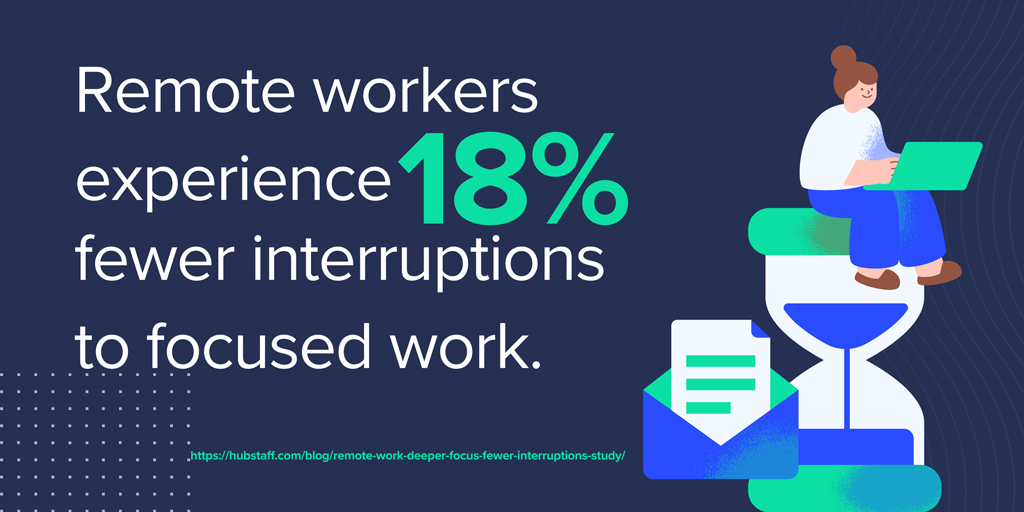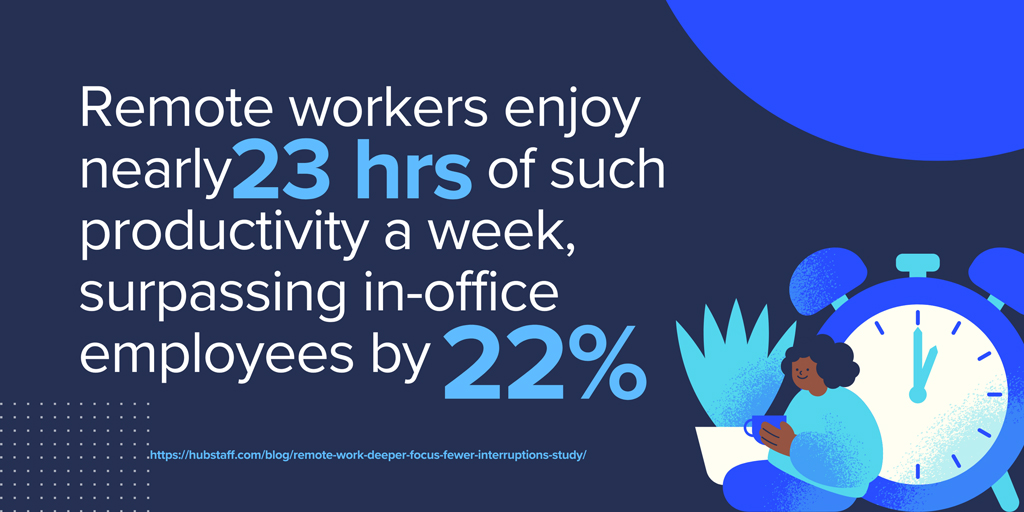Maximizing Executive Productivity May Require Remote Policies

Transforming business processes is always challenging, even when focused on only small shifts with a great change management plan. Something always feels like it will go wrong. That creates a desire to control as much of the situation as possible, mitigating risk and even potential churn.
If we ignore the boogeymen of RTO mandates and greedy executives and focus on reality, this desire for control is often what prevents companies from embracing remote work. Not seeing or knowing your team can feel like sand slipping through your fingers.
However, data shows that this is not the case and you just might build a little more success and growth with clear protections by embracing remote work. Executives can safeguard gains and get the talent they need by prioritizing productivity measures and seamless communication technology.
Trust me when I say that this frees up your time, too.
Ignore that fearful voice
By focusing on the transformative potential of remote work beyond crisis response, we can uncover insights into how this model can serve as a competitive advantage for businesses. The more digitally driven your marketplace and customer base, the more remote work naturally fits into how you operationalize.
It’s crucial we realize that remote work is just an extension of the large, traditional office. Your COO almost never could walk and meet with every individual person impacting operations in a single day. They needed to delegate and trust without seeing the daily work of most of their employees.
Two floors down in your office building might as well have been a world away.
So for leadership, the allure of remote work lies not in its flexibility, but in its capacity to unlock new levels of productivity and innovation by expanding talent pools and removing geographic limitations.
Your team has already blurred the barrier between home and office for years. Every morning you check email before a run, or late night you spend on the laptop while your kids watch TV, is remote.
Leaders who leverage this and make it available to others find themselves at the forefront of a workplace revolution, reshaping the future of work in real time.
That’s not because of any secret recipe or magic wand. It’s because talent want remote options and most of your competitors don’t realize they’ve misunderstood the beneficial, data-backed improvements remote work offers.
Misconceptions around remote work
The common belief positions remote work as a juggling act between household chores and professional responsibilities, in contrast to the office’s focused environment. This dichotomy, deeply ingrained in our work culture, overlooks the potential of remote settings for high-concentration tasks and misunderstands the amount and severity of interruptions in the office.
By leveraging first-party user data, Hubstaff performed statistically verified analysis showing that the reality of remote work disruptions sharply contrasts with popular belief. There’s an opportunity here for executives to minimize interruptions and enable top teams to generate more focused work time each week by offering flexibility to employees who want it.
The only requirement is to prioritize evidence over anecdotes.
The Office Is Rife With Work Interruptions
One of the biggest threats to your team’s productivity is the interruption. Studies tell us that it can take people more than 20 minutes to get back on task after an interruption — and this doesn’t count all that time lost during the interruption itself.
You rely on teams who must engage in deep, focused work to provide the data, insight, and projections to make informed decisions. Every interruption slows that process down and introduces the chance for error. These issues either slow down your work or support incorrect assessments, putting your company at risk.
Moving someone to a remote setting when they need to engage in deep work may protect them, by reducing the number of interruptions they experience by roughly 18%. Remote team members average 161 fewer interruptions over the course of their year.
That reduction equates to nearly 62 hours of additional work time annually based solely on how long it takes someone to get back on task.
This data not only challenges the narrative that the office inherently fosters better focus and productivity but also suggests that remote environments may be more conducive to the deep work required for complex problem-solving and innovation.
Time Spent on a Single, Focused Task
Another important element of work is they ability to sit down and get something done. Kids, coworkers, ringing phones, chatty coworkers, and other distractions can impact work at any location. So does the tendency to try and multitask, jumping from one task to another in an attempt to finish things at once.
For executives and the people they rely on, multitasking can drain effectiveness and cause issues with planning, delegation, and decision-making.
To understand the threat of multitasking in these environments, our workforce analytics platform looked at people’s habits to see when work-related issues broke concentration. Our data suggests that your remote workers spend both more hours and a larger percentage of their work week in focused work — spending at least 30 consecutive minutes on a single task and platform.
Remote workers enjoy nearly 23 hours of such productivity a week, surpassing in-office employees by 22%. This stark difference underscores the potential for remote work to contribute to overall business efficiency, especially in tasks that require deep concentration and minimal disruptions.

Challenges of Remote Work
Acknowledging the shift to remote work is not without its hurdles. Effective leadership and management strategies are critical to success, and remote work is a potential path.
To navigate these challenges successfully, leaders must not only foster a culture of autonomy, aligned with strategic objectives, and powered by objective performance metrics but also consider the broader implications for their entire workforce and the company’s growth trajectory.
For CEOs and executive leaders, it’s essential to recognize that remote work can fundamentally alter the dynamics of workplace interaction, collaboration, and productivity.
This recognition should guide a holistic approach to remote work policies that consider:
- Workforce Diversity and Inclusion: Remote work opens opportunities to tap into a global talent pool, enhancing workforce diversity. Leaders should strategize on leveraging this diversity to foster innovation and creative problem-solving, recognizing that a diverse team can contribute to a richer array of ideas and perspectives, driving the company’s growth.
- Technology Infrastructure: A robust IT infrastructure is paramount to support a dispersed workforce. Investing in secure, reliable, and user-friendly technology platforms enables seamless communication and collaboration, essential for maintaining productivity and engagement in a remote environment.
- Employee Well-being and Engagement: Remote work can blur the boundaries between personal and professional life, leading to burnout. Proactive measures, such as flexible work hours, mental health support, and regular check-ins, can help maintain a healthy work-life balance for employees, thereby enhancing job satisfaction and retention.
- Performance Management: Transitioning from traditional supervision to remote oversight requires a shift towards outcome-based performance metrics. Clear, measurable goals and regular feedback sessions can ensure that employees remain focused and motivated, contributing to the company’s objectives.
- Organizational Culture: Cultivating a strong, cohesive culture in a remote setting necessitates deliberate effort. Initiatives that promote a sense of belonging and reinforce the company’s values, mission, and goals can help unite a geographically dispersed team, ensuring that the organizational culture thrives even in a virtual environment.
- Scalability and Flexibility: As the company grows, its remote work policies must adapt. Leaders should regularly review and adjust these policies to ensure they continue to support the company’s evolving needs and goals, allowing for scalability and flexibility in operations.
By addressing these areas, CEOs and leaders can turn the challenges of remote work into opportunities for enhancing company resilience, agility, and competitiveness. Strategic planning and ongoing adaptation to the remote work model can not only support the growth of the company but also position it as a forward-thinking, employee-centric, and globally aware organization.
Strategies for Leadership:
For executives, the move towards remote work necessitates a nuanced approach:
- Data should inform RTO policies, ensuring decisions are grounded in reality rather than perception.
- Understanding the unique demands of different roles and applying remote work flexibly can maximize productivity and employee satisfaction.
- Balancing team demands with engagement and productivity data leverages remote work’s potential to minimize unnecessary interruptions, thereby enhancing focus and output.
As we navigate the evolving work landscape, it’s clear that remote work presents a compelling case for businesses seeking to enhance productivity and employee satisfaction. The embrace of remote work, as highlighted by industry leaders across sectors, underscores its potential as a strategic differentiator in the competitive business environment.
By fostering innovative management practices and leveraging data-driven insights, leaders can harness the full potential of remote work to drive their organizations toward greater efficiency and innovation.
Written by Jared Brown.
Have you read?
Best CEOs. Best Companies. Richest People (Billionaires). Richest Women (Billionaires). Richest in Each Country (Billionaires).
Bring the best of the CEOWORLD magazine's global journalism to audiences in the United States and around the world. - Add CEOWORLD magazine to your Google News feed.
Follow CEOWORLD magazine headlines on: Google News, LinkedIn, Twitter, and Facebook.
Copyright 2025 The CEOWORLD magazine. All rights reserved. This material (and any extract from it) must not be copied, redistributed or placed on any website, without CEOWORLD magazine' prior written consent. For media queries, please contact: info@ceoworld.biz








